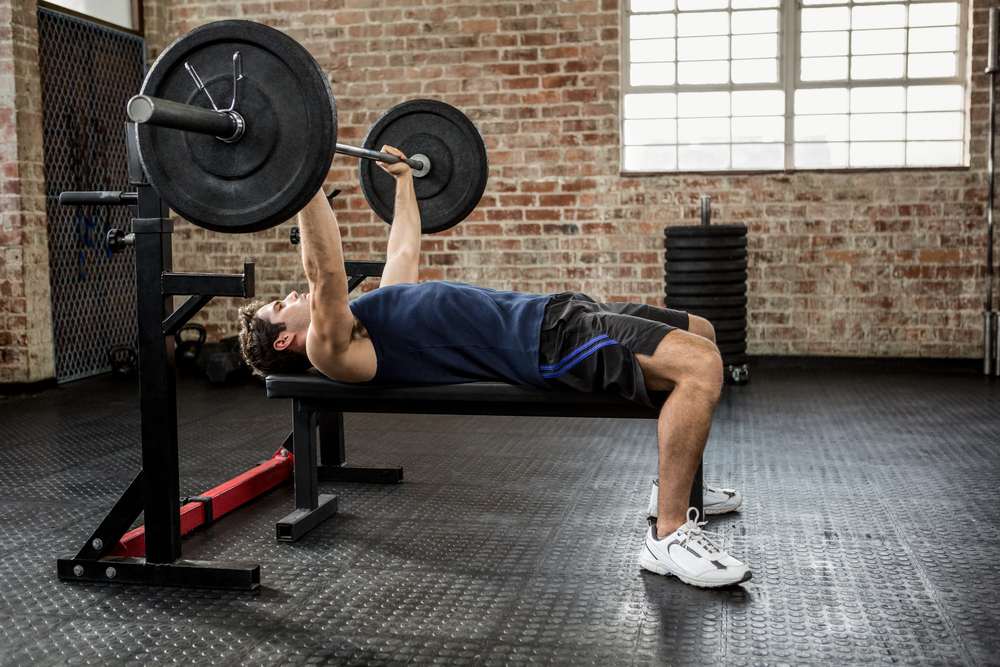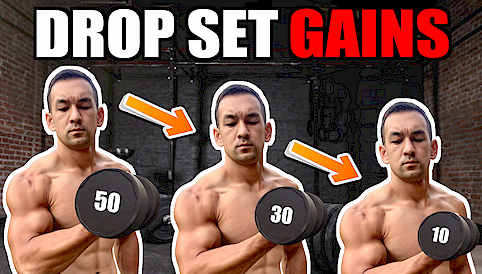DROP SETS: THE BEST WAY TO PERFORM THEM FOR MAXIMUM RESULTS
Drop sets are an excellent method for saving time at the gym while maintaining or even increasing your workout’s effectiveness.
The problem is that most people do them wrong—or at least not in a way that optimizes muscle growth.
In this article, you’ll discover what drop sets are, why they can benefit you, and how to optimally put them into action.
What Is A Drop Set?

They’re a training technique where, after you’ve completed your normal set, you immediately reduce the weight, and then continue to do more reps.
There’s no exact protocol for this. You might reduce the weight only once, crank out some more reps, and stop there. Or you might drop the weight multiple times, such as doing two, three, or even more.
Here’s an example of a drop set:
- Do as many reps as possible
- Lower the weight by 10%
- Immediately do as many reps as possible
- Lower the weight by another 10%
- Immediately do as many reps as possible
- Rest for a couple of minutes before doing your next set or start with your next exercise
If you do a drop set correctly, you’ll build up a huge “pump.” It’s undoubtedly hardcore to perform drop sets since you’ll literally be pushing yourself to the edge. But the question is:
Are Drop Sets Effective For Muscle Growth?

There’s nothing special about them from a purely bottom-line hypertrophy standpoint. A rep done in the form of a drop set isn’t more effective than a regular rep.
But still, drop sets can be a terrific tool in your training arsenal for building muscle since they allow you to do more training volume in a given timeframe. As total training volume is crucial for maximizing muscle growth, drop sets can be beneficial in that regard.
As an example, let’s say that you’re short on time and can’t do all the regular sets that your workout program calls for. You could then replace some of the usual sets with drop sets.
For instance, instead of doing four sets on the leg press, you turn that into one set that includes four drops. You can then still perform plenty of effective reps while reducing your gym time significantly.
What Does The Science Say About Drop Sets?
The current scientific literature backs up the claim that drop sets can be an effective training method for promoting muscle growth while saving time.
A case in point: one study found that drop sets are just as effective as straight sets at promoting muscle growth when total training volume is equated.
Another study found greater muscle growth with a triple drop set compared to doing three sets to failure with the same total training volume, although the difference wasn’t statistically significant.
Why is it that drop sets can be effective? One reason is that you’ll build up a lot of neuromuscular fatigue and metabolic stress, which triggers muscle growth.
For example, research found that doing a drop set of squats with a 6RM on the Smith machine with four drops of 15% (85% => 70% => 55% => 40% 1RM) produced as much metabolic stress, neuromuscular fatigue, and muscle damage as four straight sets of six reps with the initial weight.
Who Can Benefit From Drop Sets?
Drop sets should only be used sparingly by most people because they’re more taxing on the body than regular sets. Therefore, you shouldn’t replace all your current sets with drop sets.
In fact, if you’re a beginner trainee, I’d say that you shouldn’t do drop sets at all. People without much lifting experience can still maximize their progress with regular sets.
Only once you’re more advanced you might want to consider using drop sets (and even then, you don’t need them for excellent gains; you can still make fantastic progress with regular sets).
However, if you’re an advanced trainee and you’re short on time, drop sets can be a fantastic training method. Just replace the sets that you would otherwise do with a drop set.
For example, instead of doing four sets of bicep curls, turn that into one drop set with four weight reductions.
How To Use Drop Sets Effectively

Most people do drop sets wrong—or at least not in a way that would have them reap all the benefits this training method has to offer.
They treat drop sets too much like ultra-high-rep “fluff and pump work.” They reduce the weight by too large a percentage each ‘drop’ and just end up cranking out a bunch of sloppy “junk” reps.
Sure, that’ll produce a huge pump, but it won’t optimize muscle growth because you won’t reach high enough amounts of mechanical tension.
You see, muscle growth is primarily a product of performing enough reps at or near the point of muscular failure. Those last one to three reps of a set carry almost all the muscle building properties of a single set.
The easier reps that you do before that point aren’t nearly as effective. They’re there so that you can get to the point where you exert yourself maximally on the last few reps.
Those last few reps trigger the muscle building process since you’re challenging the muscle’s existing strength capacity and forcing your body to adapt further.
If you drop the weight too much and just do a bunch of sloppy reps to chase the “pump,” you won’t spend enough time doing those last few strenuous reps that actually matter.
Therefore, here’s what I recommend that you do:
Perform the drop set in such a way that whenever you reduce the weight, you’re already at failure or at least within a few reps of reaching it.
Then, don’t make those huge weight drops where you now have to pump out ten or more reps to get back to that failure point, which is what most people do.
Instead, reduce the weight just enough so that you can only do around three to five more reps in the next series. From there, reduce the weight again in a way that you can do around three to five more reps at most.
You don’t have to go to failure on every drop you do (although that would also be fine). But you do have to train hard enough that you won’t have more than one or two reps in the tank.
If you do that and ensure you won’t reduce the weight too much every drop, you’ll eliminate the unnecessary junk reps and instead do mostly effective reps. You basically trim the fat and instead do a high number of quality sets where you’re near failure, leading to a significant muscle building stimulus.
Such an approach will also prevent your cardiovascular system from being the limiting factor during the set, which is important because if you would do an excessively high number of reps, you would likely stop the set because you’re out of breath, or because it “burns too much.”
That’s not the point at which you want to stop. Instead, you want to stop when your muscles are fully taxed, which you can do better with lower reps. Your endurance then wouldn’t be an issue
Regarding how many “drops” you should do, there’s no ideal amount. In general, anywhere from one to three drops in weight would be enough to reap the desired effect.
As a disclaimer, you don’t have to add drop sets to your workout program. You can make just as much progress with regular sets as long as you do enough training volume and focus on getting stronger (i.e. progressive overload).
I don’t add drop sets to people’s workout programs by default. They’re just an optional strategy that they can use whenever they’re short on time or want to get some extra work in. Just be aware that you’ll likely be pretty sore the next day after you use drop sets, though there are ways to help relieve muscle soreness.
The Bottom Line On Drop Sets

Research shows that drop sets can be as effective for muscle growth as regular sets. Better yet, they can promote that growth while reducing the amount of time that you’ll have to spend at the gym.
Still, I don’t add drop sets to my clients’ workout programs by default since it’s not wise to use them too much given how taxing they are on the body.
Instead, I would reserve them for whenever you are short on time. With drop sets, you can still ensure that you get enough training volume to maximize muscle growth.
If this is a training method you’re interested in, I recommend checking out my post on rest-pause training to add more variety to your workouts.
If you found this article helpful, make sure to sign up for your FREE custom fitness plan below...





